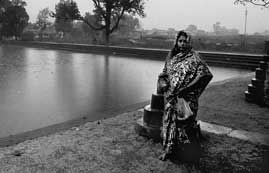RURAL WATER HARVESTING MADHYA PRADESH
 people's participation. Competitive political populism. A state government urging people to take up rainwater conservation on a big scale. These are the hallmarks of Madhya Pradesh government's effort to take up water harvesting in a big way.
people's participation. Competitive political populism. A state government urging people to take up rainwater conservation on a big scale. These are the hallmarks of Madhya Pradesh government's effort to take up water harvesting in a big way.
The year 1999 started off with a bad drought in western Madhya Pradesh. Mandsaur, known for cultivation of the water-intensive crop opium, was facing a crisis. "There was panic in the Malwa region as groundwater was depleting very fast,' says Narendra Nahata, industries minister, who belongs to Mandsaur district. Some 23 per cent of the district's agricultural land is irrigated. Only two per cent of this comes from government canals, the rest comes from private wells. The groundwater level had dipped from 9-12 metres in 1975 to 18-23 metres in 1999. Local leaders began generating awareness about overextraction of groundwater and ways to deal with it.
The first Malwa Jal Sammelan (Malwa Water Conference) was organised on June 10, 1999. People's representatives from all the panchayat s of the district were invited. The chief minister, Digvijay Singh, who presided over the meeting, called upon each elected representative to build or renovate a tank during his or her tenure. The Ek Panch Ek Talaab programme was, thus, born.
The programme, Ek Panch Ek Talaab, literally means every member of the village, block and district panchayat should become responsible for reviving or constructing a talaab (pond) or tank. The state has 350,000 members of panchayat s in its 51,000 villages. Hence, the programme could theoretically result in 350,000 ponds and tanks. Drought is likely to be the only loser.
Having implemented the Rajiv Gandhi Watershed Development Mission ( rgwdm ), perhaps the biggest programme of its kind in the world, the state has taken the next step towards drought-proofing in the face of a bad drought. As watershed development is only possible in certain areas, the state government needed a new programme of conservation that could reach out to all districts. Like rgwdm, the new programme is also decentralised and serves two purposes:
l Provides a long-term solution to drought.
l Turns water conservation into a people's movement across the state.
In January 1999, Singh had written to all collectors in the state to take up cleaning of the state's tanks and rivers. He asked the members of parliament ( mp s) and members of the legislative assembly ( mla s) of the state to contribute to this end from the local area development funds at their disposal. He called for a people's movement for restoration of waterbodies during the dry months of April and May. The reaction varied from district to district. The political leadership saw sense in this. The failure of the 1999 monsoon added urgency to the efforts. "The drought came as a blessing in disguise,' recalls Nagendra Yadav, member of the Shahdol district panchayat . "People realised the importance of water and there was an immediate acceptance of the programme with people contributing generously to it. '
The beginning
By the time the 2000 monsoon arrived, five districts, including Mandsaur, were reviving tanks (see p35). Since June 1999, 3,412 of the state's 21,319 existing tanks have been renovated and some 500 new ones have been built with an investment of Rs 16.1 crore from rural development funds allocated to the panchayati raj institutions. The voluntary labour put in by the community was worth Rs 4.85 crore. The state government has set a target to revive all existing tanks in the coming five years.
"It was assumed that the new village-level leadership that took over after the panchayat elections in December 1999-January 2000 would be more positive towards this programme,' says an aide to the chief minister. The state government has decentralised planning and has allocated a major portion of its planned expenditure to village councils, which are the nodal bodies for implementation and take all the important decisions. It is not binding on the panchayat s to spend money on water conservation. Yet they do it. As part of its drought relief operations, the state government directed district rural development agencies to spend a part of their money on water conservation. "It is a decentralised programme and depends on the panchayat 's decisions. In the absence of extra funds, communities have volunteered to fill the gap,' says Anupam Rajan, chief executive officer of Shivpuri District Rural Development Agency.
Three reporters involved in the preparations of Making Water Everybody's Business , travelled through various districts of mp to get first hand information about the implementation of the programme. They found that the programme had already started showing results by early 2001. There were reasons to make a big effort to assess the performance of the programme. The economy of mp is primarily agrarian and people
Related Content
- India State of the Environment Report : The Monthly Overview, September 2013
- MGNREGA has environmental benefits finds IISc study
- Environmental Benefits and Vulnerability Reduction through Mahatma Gandhi National Rural Employment Guarantee Scheme
- Efficacy of employment generation programs in providing water security: an assessment of MGNREGS in Madhya Pradesh
- Investing in agricultural water management to benefit smallholder farmers in Madhya Pradesh, India
- Drinking water and sanitation in rural Madhya Pradesh : Issues and challenges for policy
